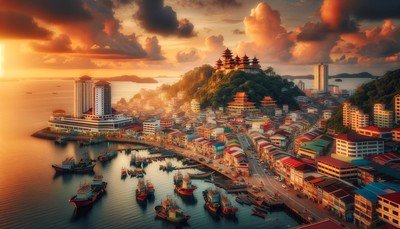Malaysia
TOUR IN
$5500
per person
Availability: 20 places
This Tour Has Been Planned But Dates Are Not Yet Definite And Due To Remote Location. Itinerary Is Subject To Change . The Itinerary Can Also Be Personalized And Tailored To A Small Group. DO NOT BOOK NOW .CONTACT US DIRECTLY travel@
Malaysia has a well-developed transportation network, making it easy to explore the country by air, rail, road, or sea. Here’s a basic guide on how to travel through Malaysia efficiently:
1. Arriving in Malaysia
- Most international travelers arrive at Kuala Lumpur International Airport (KLIA).
- Other major entry points include Penang International Airport, Kota Kinabalu International Airport, and Johor Bahru’s Senai Airport.
2. Traveling Within Peninsular Malaysia
- By Air: Domestic flights (e.g., Malaysia Airlines, AirAsia) connect major cities like Kuala Lumpur, Penang, Langkawi, and Johor Bahru.
- By Train: The KTM ETS (Electric Train Service) is a fast and comfortable option connecting Kuala Lumpur, Ipoh, Penang, and other cities.
- By Bus: Long-distance buses operate between major cities and towns, with hubs in KL Sentral, TBS (Terminal Bersepadu Selatan), and Pudu Sentral.
- By Car: Renting a car is an option for flexibility, with well-maintained highways such as the North-South Expressway (E1 & E2).
- By Ferry: Regular ferries operate to island destinations like Langkawi, Tioman, and Pangkor.
3. Traveling to and Within East Malaysia (Borneo)
- By Air: The best way to travel between Peninsular Malaysia and East Malaysia (Sabah & Sarawak) is by flight, with regular services to Kota Kinabalu, Kuching, and Miri.
- By Road: Sabah and Sarawak have extensive road networks, but some remote areas require 4WD vehicles.
- By Boat: River transport is common in rural areas, especially along the Rajang River in Sarawak and the Kinabatangan River in Sabah.
4. Public Transport in Cities
- Kuala Lumpur: MRT, LRT, Monorail, and buses (RapidKL) are efficient.
- Penang: Public buses (Rapid Penang) and ferries connect the mainland to the island.
- Johor Bahru: Public buses and taxis provide easy access to Singapore.
Day 1
Kuala Lumpur
Kuala Lumpur (KL), Malaysia’s vibrant capital, is a mix of modern skyscrapers, historic landmarks, bustling markets, and diverse food scenes. Here are some must-visit attractions and activities:
1. Iconic Landmarks
- Petronas Twin Towers – Visit the world’s tallest twin towers, enjoy the observation deck, and take in stunning city views.
- Menara Kuala Lumpur (KL Tower) – A great spot for panoramic views, with a revolving restaurant and glass-floored Sky Box.
- Merdeka Square – A historic site where Malaysia declared independence, surrounded by colonial-era buildings.
2. Cultural & Historical Sites
- Sultan Abdul Samad Building – A stunning Moorish-style building in the heart of KL.
- Thean Hou Temple – A beautiful Chinese temple with intricate architecture and city views.
- National Museum – Learn about Malaysia’s rich history and cultural heritage.
3. Shopping & Markets
- Pavilion Kuala Lumpur – A luxury shopping mall with designer brands and restaurants.
- Suria KLCC – A shopping mall at the base of the Petronas Towers.
- Central Market – A heritage site with arts, crafts, and souvenirs.
- Petaling Street (Chinatown) – A lively street market for bargain shopping, food, and souvenirs.
4. Nature & Outdoor Attractions
- Batu Caves – A Hindu temple complex set inside massive limestone caves, with a giant golden statue of Lord Murugan.
- Perdana Botanical Gardens – A peaceful park with a lake, orchid gardens, and lush greenery.
- KL Bird Park – The world’s largest free-flight aviary with exotic bird species.
- Titiwangsa Lake Gardens – A scenic park with jogging tracks, paddle boating, and a view of the KL skyline.
5. Food & Nightlife
- Jalan Alor – A famous street food haven with local favorites like satay, char kway teow, and grilled seafood.
- Changkat Bukit Bintang – A vibrant nightlife area with bars, pubs, and live music.
- Little India (Brickfields) – A great place to try authentic Indian cuisine.
- Kampung Baru – A traditional Malay neighborhood known for local street food.
6. Day Trips from KL
- Genting Highlands – A hilltop resort with a casino, theme park, and cool weather (about an hour away).
- Putrajaya – Malaysia’s administrative capital with stunning architecture and a beautiful lake.
- Fraser’s Hill – A charming colonial-style hill station for nature lovers.
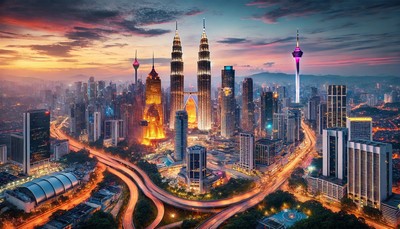
Day 2
Malacca
Malacca (Melaka), a UNESCO World Heritage city, is rich in history, colonial architecture, and cultural attractions. It offers a mix of historical landmarks, delicious food, and scenic river views. Here are the top things to do in Malacca:
1. Explore Historical Landmarks
- A Famosa – The remains of a 16th-century Portuguese fortress, one of the oldest European ruins in Southeast Asia.
- St. Paul's Church – A historic hilltop church with Dutch tombstones and panoramic views of the city.
- Christ Church Melaka – A striking red Dutch church built in the 18th century.
- The Stadthuys – A Dutch-era administrative building, now a history museum.
- Malacca Sultanate Palace Museum – A reconstruction of the Malay Sultan’s palace, showcasing the city’s royal history.
2. Stroll Along Jonker Street
- Jonker Street Night Market (Fri-Sun evenings) – A lively market with street food, souvenirs, and live performances.
- Cheng Hoon Teng Temple – Malaysia’s oldest Chinese temple, dedicated to Taoism, Confucianism, and Buddhism.
- Baba & Nyonya Heritage Museum – A museum showcasing Peranakan (Straits Chinese) culture.
3. Take a Malacca River Cruise
- A scenic boat ride along the Malacca River, passing murals, heritage buildings, and charming cafes.
4. Visit Unique Attractions
- Maritime Museum & Replica of Flor de la Mar – A replica of a Portuguese ship with exhibits on Malacca’s maritime history.
- Melaka Straits Mosque – A stunning floating mosque on the sea, perfect for sunset views.
- Kampung Morten – A traditional Malay village with well-preserved wooden houses.
5. Enjoy Malacca’s Famous Food
- Chicken Rice Balls – A local twist on Hainanese chicken rice, found at Kedai Kopi Chung Wah or Hoe Kee.
- Nyonya Laksa – A spicy coconut-based noodle soup, available at Jonker 88.
- Cendol – A sweet, icy dessert made with coconut milk, gula Melaka (palm sugar), and green jelly noodles.
- Satay Celup – Skewered meats and seafood dipped in peanut sauce, popular at Capitol Satay.
6. Visit the Beaches & Islands
- Pulau Besar – A small island with beaches and mystical legends, accessible by ferry.
- Pantai Klebang – A beach famous for its sand dunes and coconut shakes.
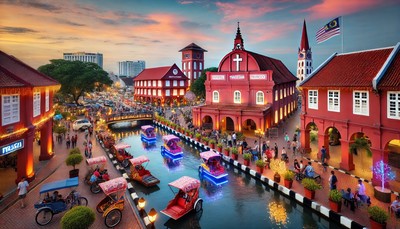
Day 3
Johor Bahru
Johor Bahru (JB), the capital of Johor, is a vibrant city known for its theme parks, shopping, food, and historical sites. Whether you're visiting for a day trip from Singapore or staying longer, here are some of the best things to do in JB:
1. Explore Theme Parks & Family Attractions
- LEGOLAND Malaysia Resort – The ultimate family-friendly theme park with rides, water slides, and a LEGO-themed hotel.
- Sanrio Hello Kitty Town & Thomas Town – A must-visit for fans of Hello Kitty and Thomas the Tank Engine.
- Austin Heights Water & Adventure Park – A fun spot with water slides, go-karting, and a high-ropes course.
2. Visit Cultural & Historical Sites
- Sultan Abu Bakar State Mosque – A stunning mosque blending Victorian and Moorish architecture, with a great view of the Straits of Johor.
- Johor Bahru Old Chinese Temple – A historic temple dedicated to five Chinese deities, showcasing JB’s rich heritage.
- Istana Besar (Grand Palace) – Formerly the Sultan’s palace, now a museum displaying royal artifacts.
- Tiong Hua Heritage Museum – A museum highlighting the history and contributions of Johor’s Chinese community.
3. Go Shopping in JB
- Johor Premium Outlets (JPO) – A paradise for brand lovers, offering discounts on designer goods.
- Paradigm Mall – One of the largest malls in JB, with shopping, a skating rink, and entertainment options.
- KSL City Mall – Popular for affordable shopping, massage parlors, and the famous Monday night market.
- City Square Mall – A favorite mall for Singaporean visitors due to its proximity to the border.
4. Enjoy the Food Scene
- Kam Long Curry Fish Head – A famous eatery serving flavorful curry fish head in clay pots.
- Hiap Joo Bakery – An old-school bakery known for its delicious banana cakes.
- Restoran Todak (Orang Asli Seafood) – A seafood restaurant by the coast, offering fresh crabs, prawns, and fish.
- Chakra Restaurant – A well-known spot for authentic North and South Indian cuisine.
- Lok Lok Street Stalls – Enjoy skewered meats and seafood cooked on the spot, best with spicy sauces.
5. Enjoy Nature & Outdoor Activities
- Danga Bay – A waterfront area with restaurants, cafes, and a mini amusement park.
- Desaru Beach (Day Trip) – A beautiful beach about an hour away, perfect for relaxing or water sports.
- Gunung Pulai – A great hiking spot with waterfalls and rainforest trails.
- Hutan Bandar Recreational Park – A peaceful green space with lakes and jogging tracks.
6. Experience JB’s Nightlife & Entertainment
- Sky 26 Bar – A rooftop bar with stunning city views.
- The Replacement – Lodge & Kitchen – A trendy café known for its all-day brunch and coffee.
- Carabao Thai Street Food – A lively night spot with Thai-style street food and music.
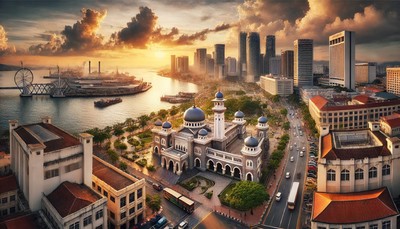
Day 4
Kuala Terengganu
Kuala Terengganu, the capital of Terengganu state, is a charming coastal city known for its stunning mosques, beautiful islands, and rich Malay culture. Here are the best things to do in Kuala Terengganu:
1. Visit Iconic Landmarks
- Crystal Mosque (Masjid Kristal) – A breathtaking mosque made of glass and steel, located in the Islamic Heritage Park.
- Islamic Heritage Park (Taman Tamadun Islam) – Features replicas of famous Islamic monuments from around the world.
- Terengganu State Museum – The largest museum in Malaysia, showcasing Terengganu’s history, culture, and Islamic artifacts.
- Kampung Cina (Chinatown) – A historical street with colorful shophouses, murals, and great local food.
2. Explore the Beaches & Islands
- Pantai Batu Buruk – A scenic beach perfect for picnics, kite flying, and enjoying local street food.
- Pulau Redang – A paradise island known for its crystal-clear waters, snorkeling, and luxury resorts.
- Pulau Kapas – A quieter island with pristine beaches and excellent diving spots.
- Pulau Tenggol – A top diving destination with vibrant marine life and coral reefs.
3. Discover Local Culture & Heritage
- Pasar Payang (Central Market) – A must-visit market for local snacks, batik, silk, and handicrafts.
- Noor Arfa Batik – A batik workshop where you can see traditional fabric-making techniques and even try it yourself.
- Floating Mosque (Masjid Tengku Tengah Zaharah) – A beautiful mosque built on a lake, giving it a floating effect.
- Kampung Losong – A village famous for making keropok lekor (traditional fish crackers).
4. Enjoy Local Food
- Keropok Lekor – A must-try Terengganu specialty, made of fish and sago, best enjoyed with chili sauce.
- Nasi Dagang – A famous dish with fragrant rice and tuna curry, often eaten for breakfast.
- Sata – Grilled fish cakes wrapped in banana leaves, similar to otak-otak.
- Ikan Celup Tepung (ICT) – Fresh seafood deep-fried in crispy batter, found at Pantai Teluk Ketapang.
- Laksam – A unique type of laksa with thick rice noodles and coconut-based fish gravy.
5. Take a River Cruise
- Sungai Terengganu River Cruise – A scenic cruise along the Terengganu River, passing mangroves, fishing villages, and historic sites.
6. Explore the Nearby Fishing Villages
- Seberang Takir Fishing Village – A charming village known for dried seafood, traditional boat-making, and stunning coastal views.
- Pulau Duyong – Famous for traditional wooden boat-making and beautiful kampung (village) scenery.
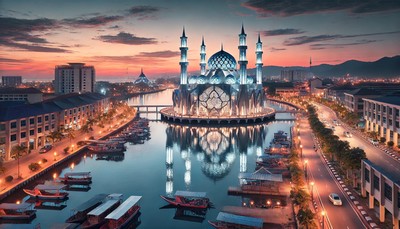
Day 5
Kenyir Elephant Conservation Village
Kenyir Elephant Conservation Village (KECV), located near Tasik Kenyir in Terengganu, is a sanctuary dedicated to the conservation and protection of elephants. It offers visitors the chance to learn about and interact with these gentle giants in a responsible and eco-friendly manner. Here’s what you can do at KECV:
1. Observe & Interact with Elephants
- Elephant Feeding – Get up close and personal by feeding elephants their favorite snacks like bananas and sugarcane.
- Elephant Bathing – Join in the fun as the elephants splash around in the river, a great way to see them in a natural setting.
- Elephant Shows & Demonstrations – Learn about elephant behavior, conservation efforts, and how these rescued elephants are cared for.
2. Explore the Sanctuary & Nature Trails
- Jungle Trekking with Elephants – Walk alongside elephants through a forest trail while learning about their natural habitat.
- Canopy Walkway – Enjoy a bird’s-eye view of the conservation area and observe elephants from above.
- Nature Trails & River Walks – Stroll through lush greenery and soak in the peaceful atmosphere.
3. Learn About Elephant Conservation
- Educational Talks & Exhibits – Gain insight into the importance of elephant conservation and how KECV helps protect Malaysia’s wild elephant population.
- Elephant Rehabilitation Program – Understand how injured or orphaned elephants are cared for before being released into the wild.
4. Enjoy the Scenic Beauty of Tasik Kenyir
- Since Kenyir Elephant Conservation Village is located near Tasik Kenyir, Malaysia’s largest man-made lake, you can combine your visit with:
- Boat cruises on the lake
- Fishing trips
- Waterfalls and caves exploration
- Jungle trekking in the surrounding rainforest
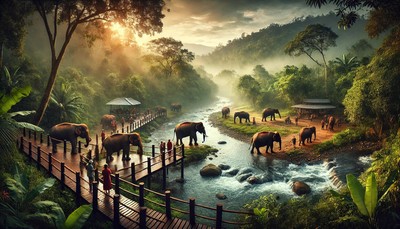
Day 6
George Town
George Town, the capital of Penang, is a UNESCO World Heritage city known for its rich history, vibrant street art, and mouthwatering food. Whether you're into culture, adventure, or just strolling through charming streets, there's plenty to explore.
1. Discover George Town’s Street Art & Heritage
- Armenian Street – Famous for its well-preserved heritage buildings and iconic murals.
- Marking George Town Sculptures – Look for iron-rod sculptures that tell stories of the city’s past.
- Street Art by Ernest Zacharevic – Must-see murals include "Kids on a Bicycle" and "Boy on a Motorcycle."
- Pinang Peranakan Mansion – A beautifully restored mansion showcasing the opulent lifestyle of the Peranakan (Straits Chinese).
- Khoo Kongsi Clan House – A stunning Chinese clanhouse with intricate carvings and rich history.
2. Explore Historical & Religious Landmarks
- Fort Cornwallis – The largest standing fort in Malaysia, offering insights into Penang’s colonial past.
- Kapitan Keling Mosque – One of Penang’s most iconic mosques, built by Indian-Muslim traders.
- St. George’s Church – The oldest Anglican church in Southeast Asia.
- Sri Mahamariamman Temple – A beautifully decorated Hindu temple with intricate sculptures.
- Cheong Fatt Tze Mansion (Blue Mansion) – A heritage hotel and museum known for its stunning indigo-blue façade.
3. Enjoy the Food Scene
George Town is a food paradise, known for its hawker stalls and heritage cafes. Some must-try dishes:
- Char Kway Teow – Stir-fried flat noodles with prawns, eggs, and Chinese sausage.
- Penang Laksa (Asam Laksa) – A tangy and spicy fish-based noodle soup.
- Nasi Kandar – Fluffy rice served with a mix of flavorful curries.
- Hokkien Mee – A prawn noodle soup with a spicy broth.
- Chendol – A refreshing dessert with coconut milk, gula Melaka (palm sugar), and green jelly noodles.
- Famous Food Spots: Gurney Drive Hawker Centre, New Lane Street Food, and Line Clear Nasi Kandar.
4. Explore Nature & Scenic Spots
- Penang Hill – Take the funicular train up for breathtaking views of George Town.
- The Habitat at Penang Hill – A rainforest experience with a canopy walk and zip-lining.
- Penang Botanic Gardens – A peaceful green space with lush gardens and monkeys.
- Clan Jetties (Chew Jetty) – A historical waterfront village built on stilts.
5. Visit Museums & Unique Attractions
- Wonderfood Museum – A quirky museum showcasing giant models of Malaysia’s iconic dishes.
- Penang Time Tunnel – A museum that takes you through Penang’s history with interactive exhibits.
- Ghost Museum Penang – A fun, spooky attraction with Southeast Asian ghost folklore.
- Penang 3D Trick Art Museum – A great place for fun and interactive photo ops.
6. Experience George Town’s Nightlife & Markets
- Love Lane – A vibrant street filled with bars, live music, and backpacker-friendly cafes.
- Hin Bus Depot – A creative arts space with weekend markets, live performances, and food trucks.
- Penang Night Markets – Batu Ferringhi Night Market is a great place for shopping and local snacks.
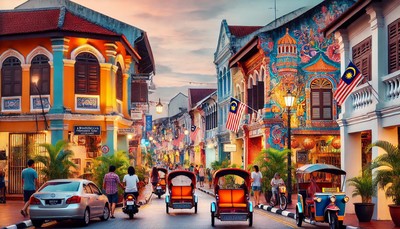
Day 7
Kuching Wetlands National Park
Kuching Wetlands National Park is a mangrove forest reserve located just 15 km from Kuching, Sarawak. Covering about 6,610 hectares, it is a UNESCO-listed site and a prime location for wildlife spotting, boat cruises, and eco-tourism adventures.
1. Go on a Mangrove Boat Cruise
- The best way to explore the park is via a boat cruise through the mangrove-lined waterways.
- Most tours depart from Telaga Air or Santubong and take you deep into the park’s rich ecosystem.
- The boat ride offers close-up views of mangroves, wildlife, and scenic landscapes.
2. Spot Rare & Endangered Wildlife
Kuching Wetlands is home to diverse wildlife, including:
- Irrawaddy Dolphins – Watch for these rare, small estuarine dolphins, often seen near river mouths.
- Proboscis Monkeys – Endemic to Borneo, these big-nosed monkeys live along the mangrove trees.
- Saltwater Crocodiles – The largest crocodile species in the world lurk in the muddy waters.
- Mudskippers & Fiddler Crabs – Small but fascinating creatures found along the riverbanks.
- Exotic Birds – Spot kingfishers, eagles, and herons in their natural habitat.
3. Experience a Sunset & Fireflies Cruise
- Book an evening cruise to see the sunset over the mangroves.
- Watch fireflies light up the trees as night falls.
- This is one of the most magical and peaceful experiences in the park.
4. Learn About the Mangrove Ecosystem
- The park plays a crucial role in protecting coastal biodiversity, fish nurseries, and carbon storage.
- Your guide will explain the importance of mangroves in preventing coastal erosion and supporting wildlife.
5. Visit Nearby Fishing Villages
- Telaga Air & Santubong Fishing Villages – Experience the local Malay fishing community lifestyle.
- Enjoy fresh seafood at local stalls after your cruise.
6. Try Kayaking (Seasonal & Guided Tours Required)
- Some operators offer kayaking tours for a more immersive experience through the narrow mangrove channels.
7. Take a Day Trip to Nearby Attractions
Since Kuching Wetlands is close to the city, you can combine your visit with:
- Santubong Peninsula – For beaches, hiking, and seafood.
- Bako National Park – If you want jungle trekking and wildlife spotting.
- Sarawak Cultural Village – To experience traditional tribal longhouses and performances.
Travel Tips for Visiting Kuching Wetlands National Park
✔ Best Time to Visit: Dry season (April–October) for better visibility of wildlife.
✔ How to Get There:
- 45-minute drive from Kuching City to Telaga Air Jetty or Santubong Jetty.
- Private tour operators offer pick-up services.
✔ Tour Options: Most require a guide and boat hire, as there are no boardwalks or hiking trails.
✔ What to Bring: Insect repellent, a hat, sunscreen, a raincoat, and binoculars for bird watching.
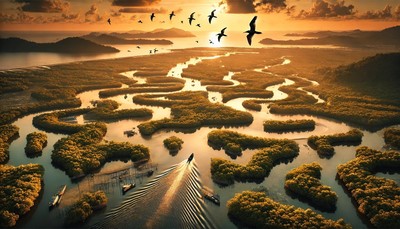
Day 8
Sibu
Sibu, located in Sarawak, Malaysia, is a vibrant town along the Rajang River with a rich mix of Chinese, Iban, and Melanau cultures. Known for its food, heritage sites, and river life, Sibu offers a unique travel experience.
1. Explore the Iconic Sibu Central Market
- Malaysia’s largest indoor market, home to over 1,200 stalls selling fresh produce, meats, and local delicacies.
- Try exotic jungle produce, fresh seafood, and traditional Iban & Melanau snacks.
2. Visit Sibu’s Religious & Historical Landmarks
- Tua Pek Kong Temple & 7-Storey Pagoda – A stunning Chinese temple with a riverside view and intricate carvings.
- Sacred Heart Cathedral – One of Sarawak’s largest churches with beautiful architecture.
- Eng Ann Teng Tua Pek Kong Temple (Bawang Assan) – One of the oldest Chinese temples in Sarawak.
- Sibu Heritage Centre – A museum showcasing Sibu’s history, cultures, and Chinese migration stories.
3. Walk Along the Sibu Waterfront & Rejang Esplanade
- Enjoy a relaxing stroll along the Rajang River, Malaysia’s longest river.
- Sunset river cruises are available, offering stunning views of floating villages and traditional wooden houses.
- Check out Sibu’s Swan Monument, as the swan is the symbol of the city.
4. Experience Iban & Melanau Culture at Bawang Assan Longhouse Village
- Visit authentic Iban longhouses where locals welcome visitors with tuak (rice wine) and traditional dance performances.
- Stay overnight in a longhouse to experience Iban hospitality.
- Learn about Melanau culture at Kampung Datu & Kampung Hilir.
5. Try Sibu’s Famous Food
Sibu is known as a food paradise, blending Foochow, Iban, and Melanau flavors. Don’t miss:
- Kampua Mee – Sibu’s famous dry noodles, similar to kolo mee.
- Dian Bian Hu – A unique Foochow rice flour noodle soup.
- Kompia – A crunchy, bagel-like Foochow pastry filled with meat.
- Mee Sua in Red Wine Chicken Soup – A comforting Foochow noodle dish.
- Umai – A Melanau dish of raw marinated fish, similar to ceviche.
- Sarawak Layer Cake (Kek Lapis Sarawak) – Available in different flavors at Sibu Night Market.
6. Visit Bukit Lima Nature Reserve
- A great spot for nature lovers, featuring wooden walkways through peat swamp forests.
- A chance to see proboscis monkeys, squirrels, and rare birds.
7. Shop at Sibu Night Market
- Open every evening, selling street food, clothes, handicrafts, and souvenirs.
- A great place to try local snacks like satay, grilled seafood, and desserts.
8. Take a River Cruise to Kapit
- Travel up the Rajang River by express boat to the remote town of Kapit, home to more traditional Iban longhouses.
- Visit the Fort Sylvia Museum, which showcases the history of the Iban warriors and Sarawak’s White Rajahs.
9. Visit Lau King Howe Hospital Memorial Museum
- Malaysia’s only medical museum, showcasing the history of Sarawak’s first modern hospital.
10. Explore Sungai Merah Heritage Walk
- A historical area where the earliest Foochow settlers arrived in Sibu.
- Learn about Foochow migration history while enjoying traditional architecture and gardens.
Bonus: Attend Festivals in Sibu
- Borneo Cultural Festival (BCF) – Held annually in July, featuring ethnic music, dance, and food stalls.
- Sibu International Dance Festival – A vibrant dance event showcasing local and international performers.
Travel Tips for Sibu
✔ Best Time to Visit: Dry season (April – October) for comfortable weather.
✔ Getting There: Flights to Sibu Airport (SBW) or express boat from Kuching/Kapit.
✔ Where to Stay: Waterfront hotels, boutique lodges, or longhouse homestays for a cultural experience.
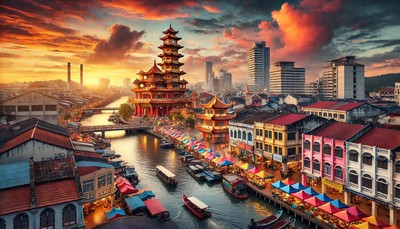
Day 9
Bintulu
Bintulu, located in Sarawak, Malaysia, is a coastal town known for its nature reserves, beautiful beaches, and rich cultural heritage. It’s a great destination for those who enjoy outdoor adventures, local markets, and indigenous traditions.
1. Explore Similajau National Park 🌿🏝️
- The best national park near Bintulu, famous for its golden sandy beaches, lush rainforests, and diverse wildlife.
- Trek through jungle trails to reach Golden Beach, a stunning secluded beach.
- Spot crocodiles, hornbills, monkeys, and sea turtles along the coastal and jungle trails.
- Enjoy camping, boat rides, and birdwatching.
2. Visit Tanjung Batu Beach 🌊🏖️
- A scenic beach perfect for relaxing, jogging, or enjoying a sunset.
- Try fresh seafood at nearby stalls.
- A great spot for family picnics and photography.
3. Experience Local Culture at Tumbina Bintulu 🦁🌴
- A mini zoo and botanical garden, home to orangutans, hornbills, crocodiles, and sun bears.
- A great place to learn about Sarawak’s flora and fauna.
- Offers panoramic views of Bintulu town from the hilltop.
4. Visit Council Negeri Monument 🏛️
- The historical site of Sarawak’s first legislative assembly (1867).
- Features a monument and beautiful landscaped gardens.
- A peaceful place for history lovers and photographers.
5. Shop & Eat at Pasar Utama & Pasar Tamu Bintulu 🛍️🍍
- Pasar Utama – A traditional wet market selling fresh seafood, fruits, and vegetables.
- Pasar Tamu Bintulu – The best place to find exotic jungle produce, handicrafts, and local snacks.
- Try Bintulu’s famous belacan (shrimp paste), a must-buy for food lovers.
6. Enjoy the Sunset at Pantai Temasya Tanjung Kidurong 🌅
- A less crowded beach, ideal for relaxing and photography.
- A favorite spot among locals for fishing and BBQ gatherings.
7. Discover Niah Caves (Day Trip from Bintulu) 🏞️🦇
- A 2-hour drive from Bintulu, Niah National Park is home to one of the oldest human settlements in Southeast Asia.
- Explore massive limestone caves, ancient cave paintings, and prehistoric burial sites.
- Visit the famous Trader’s Cave and Great Cave, where ancient humans once lived.
8. Experience Iban Culture at a Longhouse Visit 🏡🎶
- Take a tour to Iban longhouses to experience traditional dance, music, and tuak (rice wine).
- Sebauh & Pandan Longhouses are the closest options near Bintulu.
- Enjoy the warm hospitality of the Iban community and learn about their way of life.
9. Stroll Through the Bintulu Waterfront Promenade 🚶♂️
- A scenic boardwalk along the Kemena River, great for morning or evening walks.
- Spot fishing boats and local traders selling fresh seafood.
- Enjoy street food stalls and lively evening markets.
10. Try Bintulu’s Local Food 🍜🍤
Bintulu is a foodie’s paradise! Must-try dishes include:
- Umai – A traditional Melanau raw fish dish, similar to ceviche.
- Linut (Ambuyat) – A unique sago starch dish eaten with spicy sambal.
- Mee Kolok Bintulu – A dry noodle dish served with soy sauce and minced meat.
- Midin Belacan – Stir-fried jungle fern with shrimp paste.
- Bintulu Belacan – A must-buy shrimp paste, famous throughout Malaysia.
11. Attend Local Festivals & Events 🎭🎉
- Borneo International Kite Festival (September) – A colorful kite-flying event attracting international participants.
- Bintulu Regatta – A thrilling boat racing competition on the Kemena River.
- Gawai Dayak (June 1-2) – A cultural celebration of the Dayak harvest festival with dance, food, and music.
12. Take a River Cruise Along the Kemena River ⛵🐊
- A great way to see mangrove forests, fishing villages, and crocodiles in the wild.
- Visit Kampung Jepak, a traditional Melanau fishing village known for its seafood processing.
Travel Tips for Visiting Bintulu
✔ Best Time to Visit: Dry season (April–September) for outdoor activities.
✔ Getting There:
- Bintulu Airport (BTU) connects to major Malaysian cities.
- Long-distance buses link Bintulu to Miri, Sibu, and Kuching.
✔ Where to Stay: - Luxury: ParkCity Everly Hotel
- Mid-range: Promenade Hotel Bintulu
- Budget: Inn86 Hotel
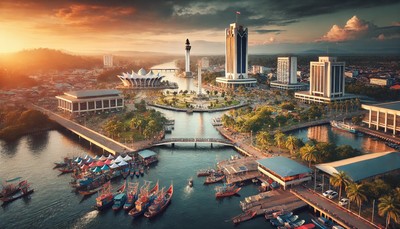
Day 10
Similajau National Park
Similajau National Park, located about 30 km from Bintulu, Sarawak, is a stunning coastal rainforest park known for golden sandy beaches, dense jungles, and diverse wildlife. Covering 8,996 hectares, it’s a paradise for nature lovers, hikers, and wildlife enthusiasts.
1. Trek Through the Jungle Trails 🌿🥾
- Main Trail (9 km to Golden Beach) – A scenic trek through coastal forests, mangroves, and secluded beaches.
- Shorter Trails:
- Selunsur Rapid Trail (6.4 km) – Leads to a beautiful jungle stream for a refreshing dip.
- Viewpoint Trail (1.7 km) – A short uphill climb offering a panoramic view of the coastline.
🚨 Tip: Bring plenty of water, wear sturdy shoes, and start early to avoid the midday heat!
2. Relax at the Stunning Beaches 🏖️
- Golden Beach – The highlight of the park, famous for its golden sand and clear waters.
- Turtle Beach I & II – Secluded beaches where sea turtles sometimes come to lay eggs.
- Sebubong Pool Beach – A hidden beach with a freshwater pool flowing into the sea.
3. Wildlife Spotting & Bird Watching 🦜🦎
- Home to 185 bird species, including hornbills, eagles, and kingfishers.
- Spot saltwater crocodiles lurking in the Similajau River.
- Encounter wild boars, macaques, bearded pigs, and monitor lizards along the trails.
- If you're lucky, you might see dolphins swimming near the coast! 🐬
🚨 Tip: The best time for wildlife spotting is early morning or late afternoon.
4. Take a Boat Tour or Kayak Along the Coast 🚤
- Rent a boat to explore hidden beaches, waterfalls, and rocky headlands.
- Enjoy kayaking along the mangrove rivers, surrounded by rich biodiversity.
5. Experience the Night Walk & Fireflies Tour 🌌🔦
- Join a guided night trek to see glowing fungi, nocturnal insects, and fireflies.
- Look out for owls, civets, and slow lorises active at night.
🚨 Tip: Bring a torchlight and wear long sleeves to protect against mosquitoes.
6. Swim at Selunsur Rapids & Jungle Streams 💦
- A refreshing freshwater stream located deep in the jungle.
- Perfect for cooling off after a long hike.
🚨 Tip: The water level depends on the season, so check with park rangers before hiking.
7. Go Fishing (With a Permit) 🎣
- Fishing is allowed in designated areas, especially near the Similajau River estuary.
- The park is rich in barramundi, catfish, and mangrove snapper.
🚨 Tip: Apply for a fishing permit from park authorities before casting your line.
8. Camp Under the Stars ⛺🌌
- Similajau National Park has basic camping facilities near the headquarters.
- Fall asleep to the sounds of the jungle and ocean waves.
🚨 Tip: Bring your own tent or check with the park office for rental options.
9. Stay Overnight in a Park Chalet 🏡
- Basic chalet accommodations are available near the entrance.
- A great option for nature lovers who want to explore the park over multiple days.
🚨 Tip: Book in advance, especially during weekends and holidays.
10. Watch the Spectacular Sunset at Viewpoint Cliff 🌅
- A breathtaking spot to watch the sunset over the South China Sea.
- Located near the park headquarters, accessible via a short hike.
Travel Tips for Visiting Similajau National Park
✔ Best Time to Visit: Dry season (March–October) for hiking and wildlife spotting.
✔ Entrance Fee: Around RM 10 (locals) / RM 20 (foreigners).
✔ Getting There:
- 30-minute drive from Bintulu (taxi or rented car).
- No public transport, so hiring a car or tour guide is recommended.
✔ What to Bring: - Hiking shoes, insect repellent, sunscreen, and plenty of water.
- Snacks or packed food (there are no restaurants inside the park).
✔ Safety Tips: - Beware of crocodiles near river areas!
- Check with rangers before swimming in remote beaches.
Final Thoughts
Similajau National Park is a hidden paradise for those who love adventure, wildlife, and untouched beaches. Whether you’re trekking, boating, or simply relaxing on a quiet beach, it’s the perfect escape from city life.
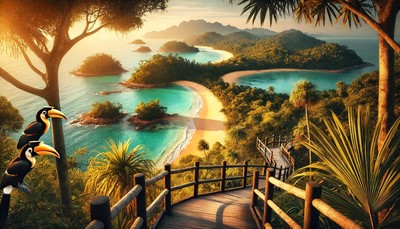
Day 11
Niah National Park
Niah National Park, located in Sarawak, Malaysia (about 1.5 hours from Miri), is famous for its massive limestone caves, prehistoric rock paintings, and ancient human remains dating back 40,000 years. It’s a must-visit for history buffs, nature lovers, and adventure seekers!
1. Explore the Famous Niah Caves 🏞️🦇
- Great Cave (Gua Niah) – The largest and most impressive cave, home to ancient human remains and millions of bats and swiftlets.
- Trader’s Cave – A former marketplace where locals once traded bird’s nests and guano (bat droppings used as fertilizer).
- Painted Cave – Features prehistoric rock paintings and the burial sites of ancient inhabitants.
- Gan Kira Cave – A hidden gem with stalactites, stalagmites, and fascinating rock formations.
🚨 Tip: Bring a flashlight or headlamp as parts of the caves are pitch dark!
2. See the Ancient Prehistoric Rock Paintings 🎨🖖
- Located inside Painted Cave, these red-colored drawings date back over 1,200 years.
- The paintings depict human figures, animals, and boats, believed to be part of ancient burial rituals.
🚨 Tip: The Painted Cave is closed for conservation, but visitors can view the paintings from a distance.
3. Walk the Niah National Park Boardwalk 🌿🚶♂️
- A 4 km wooden boardwalk leads from the park headquarters to the caves.
- Enjoy a peaceful walk through the rainforest, passing by towering dipterocarp trees, limestone cliffs, and small rivers.
- Look out for butterflies, hornbills, and monkeys along the trail.
🚨 Tip: Wear comfortable hiking shoes and bring mosquito repellent!
4. Experience the Spectacle of Bats & Swiftlets 🦇🐦
- At dusk, thousands of bats fly out of the cave, while swiftlets return to roost, creating a stunning natural spectacle.
- The swiftlets are famous for their edible bird’s nests, a prized delicacy in Chinese cuisine.
🚨 Tip: Visit the cave around sunset to witness this incredible event!
5. Visit the Archaeological Site of Early Humans ⛏️🦴
- The Niah Caves are one of Southeast Asia’s most important archaeological sites.
- In 1958, archaeologists discovered the oldest human skull in Malaysia (around 40,000 years old) inside the Great Cave.
- Learn about ancient burial practices and see remnants of wooden coffins and artifacts.
🚨 Tip: Visit the Niah Archaeological Museum (near the park entrance) before exploring the caves for better historical context.
6. Go Jungle Trekking & Wildlife Spotting 🌴🦜
- Niah National Park has several rainforest trails, offering short jungle treks and scenic viewpoints.
- Wildlife you might see:
- Hornbills, eagles, and kingfishers
- Long-tailed macaques and silvered langurs
- Monitor lizards and frogs near the rivers
🚨 Tip: For longer treks, hire a local guide for safety and better wildlife spotting opportunities.
7. Cross the Niah River by Boat ⛵
- To enter the park, visitors must take a short boat ride across the Niah River (small fee applies).
- The calm river and surrounding rainforest provide great photo opportunities.
🚨 Tip: The river ride is just 5 minutes, but it adds to the adventure and charm of visiting the park.
8. Visit Nearby Iban Longhouses 🏡
- Rumah Patrick Libau – The closest Iban longhouse near Niah National Park.
- Experience traditional Iban culture, meet the locals, and learn about their heritage and customs.
- Some longhouses offer overnight stays, where you can enjoy local food and traditional dance performances.
🚨 Tip: Arrange a longhouse visit in advance for a more immersive experience.
Travel Tips for Visiting Niah National Park
✔ Best Time to Visit: Dry season (March – October) for better hiking conditions.
✔ Entrance Fee:
- RM 10 (Malaysians)
- RM 20 (Foreigners)
✔ Getting There: - From Miri: 1.5-hour drive (110 km) by rental car or bus.
- From Bintulu: 2-hour drive (131 km).
✔ What to Bring: - Flashlight/headlamp (the caves are dark!)
- Hiking shoes & insect repellent
- Water & snacks (limited food options inside the park)
Final Thoughts
Niah National Park is a must-visit for history lovers, hikers, and nature enthusiasts. Whether you’re exploring ancient caves, spotting wildlife, or experiencing Iban culture, it’s a destination full of adventure and discovery.
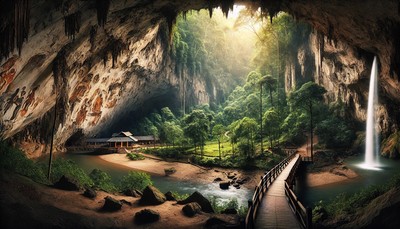
Day 12
Miri
Miri, located in Sarawak, Malaysia, is a vibrant coastal city known as the "Gateway to Northern Sarawak." It’s the perfect base for exploring national parks, diving spots, and cultural sites. Whether you're into nature, adventure, or food, Miri has something for everyone!
1. Visit Canada Hill & The Grand Old Lady 🛢️🏙️
- Climb Canada Hill for a panoramic view of Miri’s skyline and the South China Sea.
- Visit The Grand Old Lady, Malaysia’s first oil well (drilled in 1910), marking the city’s history as the birthplace of the country’s oil industry.
- Explore the Petroleum Museum, which showcases the history of Malaysia’s oil industry.
🚨 Tip: Best visited during sunset for amazing views!
2. Relax at Miri’s Beautiful Beaches 🏖️🌅
- Tusan Beach – Famous for its unique rock formations and occasional "Blue Tears" bioluminescent waves.
- Luak Esplanade – A local favorite for sunsets, BBQ gatherings, and kite flying.
- Hawai Beach – A peaceful and less crowded beach, great for relaxation.
- Bungai Beach – A hidden gem with golden sands and crystal-clear waters.
🚨 Tip: Bring a camera to capture the sunset beauty of Miri’s coastline!
3. Explore Mulu National Park (UNESCO World Heritage Site) 🏞️🦇
- Home to some of the world’s largest and most impressive caves, including:
- Deer Cave – One of the largest cave passages in the world.
- Sarawak Chamber – The biggest underground cave chamber on Earth.
- Clearwater Cave – Features a subterranean river and beautiful limestone formations.
- Witness the Bat Exodus at sunset, when millions of bats fly out of Deer Cave in search of food.
- Try the Mulu Canopy Walk, one of the world’s longest tree canopy walkways!
🚨 Tip: Flights from Miri to Mulu take about 30 minutes.
4. Visit Niah National Park (Ancient Caves & Prehistoric Paintings) 🏕️🎨
- See prehistoric cave paintings and 40,000-year-old human remains inside Niah Caves.
- Explore the massive Great Cave, where millions of bats and swiftlets reside.
- Take a boat ride across the Niah River to start your adventure.
🚨 Tip: 1.5-hour drive from Miri (great for a day trip).
5. Go Diving or Snorkeling at Miri-Sibuti Coral Reefs 🤿🐠
- One of Malaysia’s top diving destinations, known for pristine coral reefs and diverse marine life.
- Spot sea turtles, reef sharks, and colorful fish.
- Popular dive sites:
- Eve’s Garden – Known for soft corals and clownfish.
- Anemone Garden – Rich in sea anemones and vibrant fish.
- Belais Reef – A deep-sea site with impressive marine biodiversity.
🚨 Tip: Best visited between March – October for ideal diving conditions.
6. Discover Miri’s Markets & Shopping Scene 🛍️
- Tamu Muhibbah Market – A traditional market selling fresh produce, handicrafts, and Sarawakian spices.
- Miri Handicraft Centre – The best place to buy local crafts, Iban textiles, and beadwork.
- Bintang Megamall & Permaisuri Imperial City Mall – Modern malls with international brands and local food outlets.
🚨 Tip: Try Sarawak Laksa and Iban-style barbecue at food stalls nearby!
7. Visit Lambir Hills National Park (Trekking & Waterfalls) 🌳💦
- Famous for jungle trekking, waterfalls, and rich biodiversity.
- Latak Waterfall – A stunning cascade with a swimming pool at its base.
- Jungle trails range from easy walks to challenging hikes with viewpoints.
- Spot gibbons, hornbills, and exotic plants along the way!
🚨 Tip: 30-minute drive from Miri – perfect for a half-day trip.
8. Enjoy a Sunset River Cruise at Miri Marina ⛵🌅
- Take a relaxing boat cruise along the river while enjoying Miri’s skyline and coastal beauty.
- Spot fireflies, crocodiles, and mangrove wildlife.
🚨 Tip: Sunset cruises offer the best views – book in advance!
9. Visit Loagan Bunut National Park (Sarawak’s Largest Natural Lake) 🐊🦜
- Famous for its seasonal disappearing lake, unique in Southeast Asia.
- Spot crocodiles, hornbills, and rare fish species.
- Experience boat rides and bird watching in the serene surroundings.
🚨 Tip: Located 2 hours from Miri – ideal for a nature day trip.
10. Experience Miri’s Nightlife & Food Scene 🍻🍜
- Coco Cabana – A lively waterfront area with bars, seafood restaurants, and live music.
- Taman Selera Food Centre – A famous hawker center for BBQ seafood, grilled stingray, and satay.
- The Loft & Ming Café – Popular for cocktails, craft beer, and Western food.
- Lutong Night Market – A local favorite for cheap and delicious street food.
🚨 Tip: Try Umai (Melanau-style raw fish salad) and Miri’s famous noodle dishes!
11. Visit Tusan Cliff for the "Blue Tears" Phenomenon 🌊✨
- Occasionally, bioluminescent plankton cause the waves to glow blue at night.
- Even without the "Blue Tears," the rock formations and cliffs make for a stunning visit.
🚨 Tip: Best seen on moonless nights after heavy rain!
Travel Tips for Visiting Miri
✔ Best Time to Visit: March – October for outdoor activities and diving.
✔ Getting There:
- Miri Airport (MYY) connects to Kuala Lumpur, Kuching, and Kota Kinabalu.
- Buses available from Brunei, Limbang, and Bintulu.
✔ Where to Stay: - Luxury: Pullman Miri Waterfront
- Mid-range: Imperial Hotel Miri
- Budget: Mercure Miri City Centre
Final Thoughts
Miri is a hidden gem with adventure, culture, and breathtaking nature. Whether you're exploring caves, diving in coral reefs, or enjoying the beach, there’s something for everyone in this Sarawakian paradise.
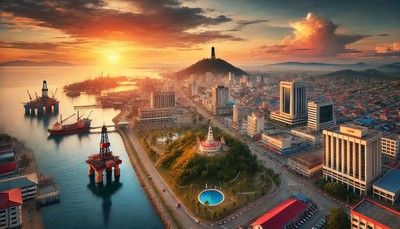
Day 13
Sabah Agricultural Park
Located in Tenom, Sabah, the Sabah Agricultural Park is a beautiful botanical and agro-tourism park that offers visitors a chance to experience Sabah’s diverse plant life, tropical fruits, and traditional gardens. Covering 200 hectares, it is a must-visit for nature lovers, gardeners, and families!
1. Explore the Themed Gardens & Plant Collections 🌺🌴
The park features various gardens showcasing Sabah’s native and exotic plants:
- Orchid Garden – Home to over 400 species of orchids, including rare and endemic species like the Paphiopedilum rothschildianum (Rothschild’s slipper orchid).
- Bromeliad & Fern Garden – Displays a wide variety of exotic bromeliads and ferns in a lush tropical setting.
- Cactus House – Features rare cacti and succulents from around the world.
- Model Garden – Provides landscaping inspiration, showcasing different gardening styles.
🚨 Tip: Best visited in the morning when the flowers are in full bloom!
2. Visit the Native Fruits & Crops Garden 🍍🌾
- See fruit orchards with tropical fruits like durian, rambutan, pineapple, mango, and banana.
- Learn about Sabah’s indigenous crops, including rice, cocoa, rubber, and coffee plantations.
- During fruiting seasons, you might get to sample fresh fruits straight from the trees!
🚨 Tip: The best time for fruit tasting is between June – August when most tropical fruits are in season.
3. Discover the Evolution Garden (Prehistoric Plant Walk) 🌿🦖
- Walk through a living museum of ancient plants, featuring species that date back to prehistoric times.
- See giant ferns, cycads, and primitive conifers that once thrived alongside dinosaurs.
🚨 Tip: This is a great educational experience for kids and botany lovers!
4. Learn About Sabah’s Indigenous Ethnobotany & Medicinal Plants 🌱💊
- Visit the Ethnobotanical Garden to see plants used by Sabah’s native tribes for medicine, food, and rituals.
- Learn about traditional herbal remedies from the Kadazan-Dusun, Murut, and Rungus communities.
🚨 Tip: Join a guided tour for in-depth knowledge about these plants and their cultural significance!
5. Walk Around the Lake & Enjoy the Scenic Views 🌊🦆
- Relax by the man-made lake, home to lotus flowers, fish, and migratory birds.
- Rent a paddle boat to explore the lake at your own pace.
- Perfect for picnics and photography!
🚨 Tip: Bring binoculars if you love birdwatching!
6. Visit the Bee & Honey Production Area 🐝🍯
- Learn about beekeeping and honey production in Sabah.
- See stingless bees (kelulut bees) that produce unique, medicinal honey.
- Try fresh, organic honey straight from the hive!
🚨 Tip: Great place to buy pure Sabah honey as a souvenir!
7. Go Camping or Stay Overnight in a Chalet ⛺🏡
- The park offers basic chalets and camping grounds for visitors who want to experience a night in nature.
- Enjoy cool weather, stargazing, and jungle sounds at night.
🚨 Tip: Book your chalet or campsite in advance if visiting on weekends!
8. Enjoy Local Food at the Park’s Café 🍛🥭
- Try Sabah’s local dishes, including Hinava (fish salad), Tenom coffee, and tropical fruit desserts.
- Enjoy a refreshing coconut drink or fresh pineapple juice after a long walk.
🚨 Tip: If you’re visiting in a group, you can pre-arrange a farm-to-table lunch with fresh local ingredients!
9. Shop for Souvenirs & Agricultural Products 🎁🌾
- Buy fresh fruits, honey, coffee, and traditional herbs from the park’s souvenir shop.
- Look for Tenom’s famous coffee beans, known for their strong and rich flavor.
🚨 Tip: If you love gardening, you can also buy seedlings and ornamental plants here!
10. Join Special Events & Gardening Workshops 🌻👩🌾
- The park occasionally hosts gardening workshops, fruit festivals, and nature walks.
- Check their schedule for events like orchid shows and tree-planting activities.
🚨 Tip: Visit during the Sabah Agriculture Carnival (July – September) for special exhibits and plant sales!
Travel Tips for Visiting Sabah Agricultural Park
✔ Best Time to Visit: Morning (8 AM – 11 AM) when it's cool and flowers are in bloom.
✔ Opening Hours: Daily from 8:00 AM – 5:00 PM.
✔ Entrance Fee:
- RM 10 (Malaysians)
- RM 20 (Foreigners)
- Free for kids under 12!
✔ Getting There: - By car: 2-hour drive from Kota Kinabalu (130 km).
- By train: Take the Sabah State Railway from Kota Kinabalu to Tenom, then a taxi to the park.
✔ What to Bring: - Comfortable walking shoes & hat
- Sunscreen & insect repellent
- Camera for beautiful flower and landscape shots!
Final Thoughts 🌱🌞
Sabah Agricultural Park is a hidden gem for nature lovers, gardeners, and families. Whether you want to explore exotic plants, taste tropical fruits, or learn about indigenous herbal medicine, this park offers a peaceful and educational getaway in Sabah’s highlands.
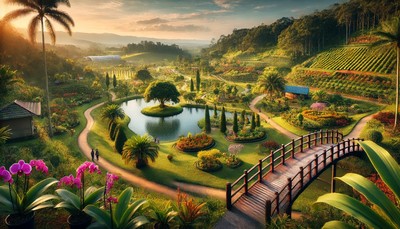
Day 14
Sandakan
Sandakan, located in Sabah, Malaysia, is a paradise for wildlife lovers, history buffs, and foodies. Known as the "Nature City", it is the gateway to orangutan sanctuaries, river cruises, and World War II heritage sites.
1. Visit Sepilok Orangutan Rehabilitation Centre 🦧🌿
- One of the best places in the world to see rescued and rehabilitated orangutans in a natural environment.
- Watch feeding sessions at 10:00 AM & 3:00 PM, when orangutans come out of the forest.
- Walk along the jungle boardwalks to see young orangutans learning survival skills.
🚨 Tip: Arrive early to get a good spot at the feeding platform!
2. Explore Bornean Sun Bear Conservation Centre (BSBCC) 🐻☀️
- Located next to Sepilok, this is the only conservation center for Malayan sun bears in the world.
- Walk on elevated platforms to see these adorable "honey bears" in a semi-wild habitat.
🚨 Tip: Sun bears are shy, so be patient while watching for them!
3. Cruise Along Kinabatangan River (Wildlife Safari) 🚤🐊
- One of the best wildlife destinations in Borneo, home to proboscis monkeys, pygmy elephants, hornbills, and crocodiles.
- Take an early morning or sunset river cruise for the best chance to see wild animals in their natural habitat.
- Stay at a jungle lodge in Sukau or Bilit for an overnight experience.
🚨 Tip: The best time to visit is during the dry season (March – October) for higher wildlife sightings.
4. Visit Labuk Bay Proboscis Monkey Sanctuary 🐵🌱
- Get up close to Borneo’s unique proboscis monkeys, known for their big noses and potbellies.
- Daily feeding sessions at 9:30 AM, 11:30 AM, 2:30 PM & 4:30 PM.
- Unlike other sanctuaries, visitors can stand close to the monkeys for amazing photo opportunities.
🚨 Tip: Bring a good camera for wildlife shots – these monkeys are very photogenic!
5. Discover Sandakan’s WWII History at the Sandakan Memorial Park 🎖️🕊️
- A WWII memorial site built on the grounds of the Sandakan Prisoner of War (POW) Camp.
- Learn about the tragic Sandakan Death Marches, where over 2,400 Allied soldiers lost their lives.
- Peaceful gardens and historical exhibits make it a moving experience for visitors.
🚨 Tip: This is a must-visit for history lovers, and it’s free entry!
6. Explore the Rainforest Discovery Centre (RDC) 🌳🦜
- One of the best places for birdwatching in Sabah, home to 250+ bird species like hornbills, kingfishers, and the Bornean bristlehead.
- Walk on the Canopy Walkway for a bird’s-eye view of the rainforest.
- Offers night walks to spot civets, slow lorises, and flying squirrels.
🚨 Tip: Sunset and early morning are the best times for birdwatching!
7. Visit Puu Jih Shih Buddhist Temple 🏯🐉
- A stunning hilltop Chinese temple with panoramic views of Sandakan Bay.
- Features golden Buddha statues, intricate dragon carvings, and peaceful gardens.
🚨 Tip: Best time to visit is during sunset for breathtaking views!
8. Experience the Local Seafood & Sandakan Food Scene 🍜🦐
Sandakan is famous for its seafood and unique Sabah cuisine! Some must-try dishes:
- Seafood Bak Kut Teh – A Sandakan specialty (pork or seafood herbal soup).
- UFO Tarts – A local dessert with custard and meringue topping.
- San Da Gen Kopitiam – Famous for traditional Malaysian breakfast, UFO tarts, and toast with kaya & butter.
- Sim Sim Water Village – A unique floating restaurant area for fresh seafood dining.
🚨 Tip: Head to Pasar Kim Fung Night Market for cheap and delicious street food!
9. Visit Turtle Islands Park (Pulau Selingan) 🐢🏝️
- A protected marine park where visitors can watch endangered sea turtles lay eggs at night.
- Includes snorkeling in crystal-clear waters and exploring pristine beaches.
- Only limited visitors per night, so book in advance!
🚨 Tip: Best time to visit is between July – October, when turtle nesting is most active!
10. Take a Trip to Gomantong Caves 🦇🏔️
- One of Borneo’s largest limestone caves, home to millions of bats and swiftlets.
- Famous for edible bird’s nests, harvested for traditional Chinese medicine.
- Watch the bat exodus at dusk – a spectacular sight!
🚨 Tip: Bring a hat and face mask – the cave has a strong guano (bat poop) smell!
11. Walk Around Sandakan Heritage Trail 🏛️🚶♂️
- A self-guided trail through historical landmarks, including:
- Agnes Keith House – Former home of a famous American author who wrote about her life in Borneo.
- St. Michael’s and All Angels Church – One of Sabah’s oldest stone churches.
- 100 Steps Staircase – A scenic walkway with panoramic city views.
🚨 Tip: Wear comfortable shoes, as some sections involve uphill walking!
12. Stay at a Jungle Lodge for an Unforgettable Experience 🌲🏡
- Enjoy an overnight stay in a rainforest lodge near Sepilok or Kinabatangan.
- Wake up to monkeys, hornbills, and the sounds of nature.
🚨 Top Lodges:
- Sepilok Nature Resort (Luxury stay in the jungle 🌿)
- Sukau Rainforest Lodge (Award-winning eco-lodge 🏕️)
- Bilit Adventure Lodge (Affordable and rustic 🛖)
Travel Tips for Visiting Sandakan
✔ Best Time to Visit: March – October (dry season, best for wildlife watching).
✔ Getting There:
- Flight: Direct flights to Sandakan Airport (SDK) from Kota Kinabalu & Kuala Lumpur.
- Boat: Speedboats to Turtle Islands & Kinabatangan River lodges.
✔ Where to Stay: - Luxury: Four Points by Sheraton Sandakan
- Mid-range: Sabah Hotel
- Budget: Sandakan Backpackers Hostel
Final Thoughts 🌿🦧
Sandakan is a wildlife and history lover’s paradise. Whether you’re watching orangutans in Sepilok, cruising the Kinabatangan River, or learning about WWII history, there’s something for every traveler.
